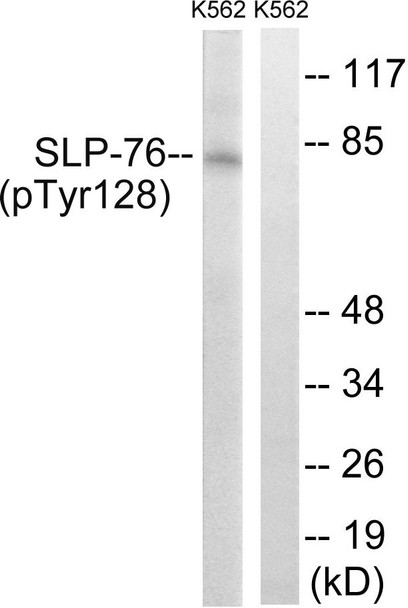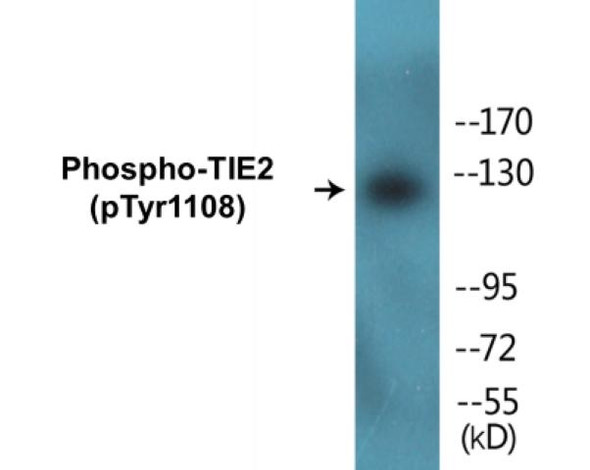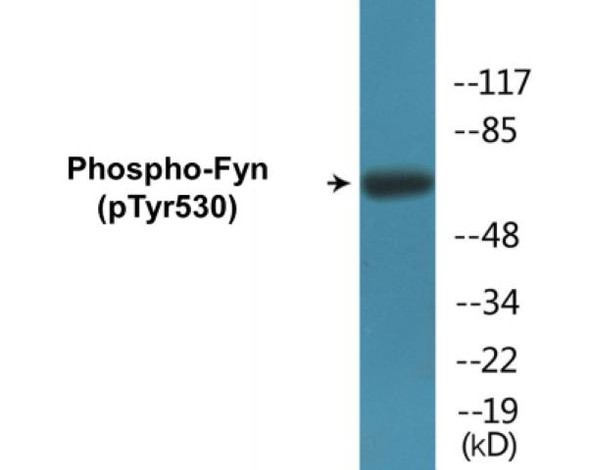Description
SLP-76 (Phospho-Tyr128) Cell-Based ELISA Kit
The SLP-76 (Phospho-Tyr128) Cell-Based ELISA Kit is a convenient, lysate- free, high throughput and sensitive assay kit that can monitor SLP-76 phosphorylation and expression profile in cells. The kit can be used for measuring the relative amounts of phosphorylated SLP-76 in cultured cells as well as screening for the effects that various treatments, inhibitors (ie. siRNA or chemicals), or activators have on SLP-76 phosphorylation.
How does our SLP-76 (Phospho-Tyr128) Fluorometric Cell-Based ELISA Kit work?
Qualitative determination of SLP-76 (Phospho-Tyr128) concentration is achieved by an indirect ELISA format. In essence, SLP-76 (Phospho-Tyr128) is captured by SLP-76 (Phospho-Tyr128)-specific primary (1°) antibodies while Dye 1-conjugated and Dye 2-conjugated secondary (2°) antibodies bind the Fc region of the 1° antibody. Through this binding, the dye conjugated to the 2° antibody can emit light at a certain wavelength given proper excitation, hence allowing for a fluorometric detection method. Due to the qualitative nature of the Cell-Based ELISA, multiple normalization methods are needed:
| 1. | A monoclonal antibody specific for human GAPDH is included to serve as an internal positive control in normalizing the target RFU values. |
| 2. | An antibody against the nonphosphorylated counterpart of SLP-76 (Phospho-Tyr128) is also provided for normalization purposes. The RFU values obtained for non-phosphorylated SLP-76 can be used to normalize the RFU value for phosphorylated SLP-76. |
SLP-76 (Phospho-Tyr128) Fluorometric Cell-Based ELISA Kit -Information
| Product Name: | SLP-76 (Phospho-Tyr128) Fluorometric Cell-Based ELISA Kit |
| Product Code/SKU: | FBCAB00100 |
| Description: | The SLP-76 (Phospho-Tyr128) Fluorometric Cell-Based Phospho ELISA Kit is a convenient, lysate-free, high throughput and sensitive assay kit that can monitor SLP-76 (Phospho-Tyr128) protein phosphorylation and expression profile in cells. The kit can be used for measuring the relative amounts of phosphorylated SLP-76 (Phospho-Tyr128) in cultured cells as well as screening for the effects that various treatments, inhibitors (ie. siRNA or chemicals, or activators have on LCP2 phosphorylation. |
| Dynamic Range: | > 5000 Cells |
| Detection Method: | Fluorometric |
| Storage/Stability: | 4°C/6 Months |
| Reactivity: | Human, Mouse, Rat |
| Assay Type: | Cell-Based ELISA |
| Database Links: | Gene ID: 3937, UniProt ID: Q13094, OMIM #: 601603, Unigene #: Hs.304475 |
| Format: | Two 96-Well Plates |
| NCBI Gene Symbol: | LCP2 |
| Sub Type: | Phospho |
| Target Name: | Phospho-LCP2 (Tyr128) |
Kit Principle
Figure: Schematic representation of Assay Genie Cell-Based Fluorometric ELISA principle
Kit components | Quantity |
| 96-Well Black Cell CultureClear-Bottom Microplate | 2 plates |
| 10X TBS | 24 ml |
| Quenching Buffer | 24 ml |
| Blocking Buffer | 50 ml |
| 15X Wash Buffer | 50 ml |
| Primary Antibody Diluent | 12 ml |
| 100x Anti-Phospho Target Antibody | 60 µl |
| 100x Anti-Target Antibody | 60 µl |
| Anti-GAPDH Antibody | 110 µl |
| Dye-1 Conjugated Anti-Rabbit IgG Antibody | 6 ml |
| Dye-2 Conjugated Anti-Mouse IgG Antibody | 6 ml |
| Adhesive Plate Seals | 2 seals |
Additional equipment and materials required
The following materials and/or equipment are NOT provided in this kit but are necessary to successfully conduct the experiment:
- Fluorescent plate reader with two channels at Ex/Em: 651/667 and 495/521
- Micropipettes capable of measuring volumes from 1 µl to 1 ml
- Deionized or sterile water (ddH2O)
- 37% formaldehyde (Sigma Cat# F-8775) or formaldehyde from other sources
- Squirt bottle, manifold dispenser, multichannel pipette reservoir or automated microplate washer
- Graph paper or computer software capable of generating or displaying logarithmic functions
- Absorbent papers or vacuum aspirator
- Test tubes or microfuge tubes capable of storing ≥1 ml
- Poly-L-Lysine (Sigma Cat# P4832 for suspension cells)
- Orbital shaker (optional)
Kit Protocol
This is a summarized version of the kit protocol. Please view the technical manual of this kit for information on sample preparation, reagent preparation and plate lay out.
| 1. | Seed 200 µl of desired cell concentration in culture medium into each well of the 96-well plates. For suspension cells and loosely attached cells, coat the plates with 100 µl of 10 µg/ml Poly-L-Lysine (not included) to each well of a 96-well plate for 30 minutes at 37°C prior to adding cells. |
| 2. | Incubate the cells for overnight at 37°C, 5% CO2. |
| 3. | Treat the cells as desired. |
| 4. | Remove the cell culture medium and rinse with 200 µl of 1x TBS, twice. |
| 5. | Fix the cells by incubating with 100 µl of Fixing Solution for 20 minutes at room temperature. The 4% formaldehyde is used for adherent cells and 8% formaldehyde is used for suspension cells and loosely attached cells. |
| 6. | Remove the Fixing Solution and wash the plate 3 times with 200 µl 1x Wash Buffer for 3 minutes. The plate can be stored at 4°C for a week. |
| 7. | Add 100 µl of Quenching Buffer and incubate for 20 minutes at room temperature. |
| 8. | Wash the plate 3 times with 1x Wash Buffer for 3 minutes each time. |
| 9. | Dispense 200 µl of Blocking Buffer and incubate for 1 hour at room temperature. |
| 10. | Wash 3 times with 200 µl of 1x Wash Buffer for 3 minutes each time. |
| 11. | Add 50 µl of Primary Antibody Mixture P to corresponding wells for SLP-76 (Phospho-Tyr128) detection. Add 50 µl of Primary Antibody Mixture NP to the corresponding wells for total SLP-76 detection. Cover the plate with parafilm and incubate for 16 hours (overnight) at 4°C. If the target expression is known to be high, incubate for 2 hours at room temperature. |
| 12. | Wash 3 times with 200 µl of 1x Wash Buffer for 3 minutes each time. |
| 13. | Add 50 ul of Secondary Antibody Mixture to corresponding wells and incubate for 1.5 hours at room temperature in the dark. |
| 14. | Wash 3 times with 200 µl of 1x Wash Buffer for 3 minutes each time. |
| 15. | Read the plate(s) at Ex/Em: 651/667 (Dye 1) and 495/521 (Dye 2). Shield plates from direct light exposure. |
| 16. | Wash 3 times with 200 µl of 1x Wash Buffer for 5 minutes each time. |
SLP-76 (Phospho-Tyr128) - Protein Information
| UniProt Protein Function: | SLP76: an adaptor protein involved in signaling through the T cell antigen receptor complex and signaling in other hematopoietic lineages including platelets. Originally identified as a substrate of the ZAP-70 protein tyrosine kinase following T cell receptor (TCR) ligation. Platelets deficient in SLP76 do not couple GPVI engagement with the signaling cascade that induces degranulation and aggregation in response to collagen. Contains four domains: a COOH-terminal SH2 domain, a central proline-rich domain, an NH2-terminal sterile {alpha} motif domain, and acidic region that contains three tyrosine phosphorylation motifs: Y112ESP, Y128ESP, and Y145EPP. pY112 and pY128 bind SH2 domains of Vav and Nck. pY145 is recognized by SH2 domains of the Tec family kinases Itk and Btk. Highly expressed in spleen, thymus, peripheral blood leukocytes, mast cells, platelets, and T-cell and monocytic cell lines. Expressed at lower level in B-cell lines. Not detected in fibroblast or neuroblasatoma cell lines. |
| UniProt Protein Details: | Protein type:Adaptor/scaffold Chromosomal Location of Human Ortholog: 5q35.1 Cellular Component: cytosol Molecular Function:protein binding Biological Process: immune response; platelet activation; positive regulation of protein kinase activity; T cell receptor signaling pathway; transmembrane receptor protein tyrosine kinase signaling pathway |
| NCBI Summary: | SLP-76 was originally identified as a substrate of the ZAP-70 protein tyrosine kinase following T cell receptor (TCR) ligation in the leukemic T cell line Jurkat. The SLP-76 locus has been localized to human chromosome 5q33 and the gene structure has been partially characterized in mice. The human and murine cDNAs both encode 533 amino acid proteins that are 72% identical and comprised of three modular domains. The NH2-terminus contains an acidic region that includes a PEST domain and several tyrosine residues which are phosphorylated following TCR ligation. SLP-76 also contains a central proline-rich domain and a COOH-terminal SH2 domain. A number of additional proteins have been identified that associate with SLP-76 both constitutively and inducibly following receptor ligation, supporting the notion that SLP-76 functions as an adaptor or scaffold protein. Studies using SLP-76 deficient T cell lines or mice have provided strong evidence that SLP-76 plays a positive role in promoting T cell development and activation as well as mast cell and platelet function. [provided by RefSeq, Jul 2008] |
| UniProt Code: | Q13094 |
| NCBI GenInfo Identifier: | 10720065 |
| NCBI Gene ID: | 3937 |
| NCBI Accession: | Q13094.1 |
| UniProt Secondary Accession: | Q13094,Q53XV4, A8KA25, |
| UniProt Related Accession: | Q13094 |
| Molecular Weight: | 60188 Da |
| NCBI Full Name: | Lymphocyte cytosolic protein 2 |
| NCBI Synonym Full Names: | lymphocyte cytosolic protein 2 |
| NCBI Official Symbol: | LCP2 |
| NCBI Official Synonym Symbols: | SLP76; SLP-76 |
| NCBI Protein Information: | lymphocyte cytosolic protein 2 |
| UniProt Protein Name: | Lymphocyte cytosolic protein 2 |
| UniProt Synonym Protein Names: | SH2 domain-containing leukocyte protein of 76 kDa; SLP-76 tyrosine phosphoprotein; SLP76 |
| Protein Family: | Larval cuticle protein |
| UniProt Gene Name: | LCP2 |
| UniProt Entry Name: | LCP2_HUMAN |







